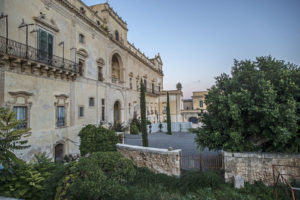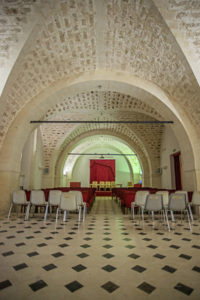The palace is accessed through the large monumental portal, large enough for carriages to pass through. The portal leads into the inner garden, or up two staircases you can reach the first floor.
The internal elevation on the south courtyard is reminiscent of the main one but is more articulated.
It has two levels marked by windows and two large round arcades in the centre.
On the piano nobile (main floor), the first floor, the reception rooms are distributed one after the other along the corridor in an “enfilade”, and all overlook the internal garden lit with natural light thanks to the large windows dotted on the internal elevation.


 In the rooms there are frescoed and richly decorated cloister vaults, the walls are covered with fabric wallpaper and the windows concealed by precious curtains.
In the rooms there are frescoed and richly decorated cloister vaults, the walls are covered with fabric wallpaper and the windows concealed by precious curtains.
The floors are typically tiled and decorated with geometric and curvilinear motifs.
It was also customary for the Baron’s bedroom to be adjacent to the reception rooms.
On the mezzanine floor, the one at a smaller height than the others, there were the children’s and staff rooms with their respective service rooms.
The other mezzanine floor located in the north-east corner, which now houses the municipal library and other spaces owned by the Municipality of Noto, was intended for the extended family.
Lastly, the attics housed the servants’ apartments, pantries and kitchens.